DALL-E podcast is a recently launched podcast that takes you on a ride to the beguiling world of artificial intelligence, popularly known as AI. Liste
DALL-E podcast is a recently launched podcast that takes you on a ride to the beguiling world of artificial intelligence, popularly known as AI. Listening alone is incredibly fascinating since it provides a nearly firsthand-experience type of glimpse of the latest development of DALL-E 2, its robotics and automation, the multifarious possibilities it is capable of, and the impact of its creation on the welfare of human society.
Additionally, it delves into the compelling perspectives of multiple geniuses behind Dall-E comprising the structural machinery, the development considerations such as its promising potential in transforming lives and industries as well as risks and setbacks ranging from confidentiality to employment concerns. It is, in every aspect, thought-provoking, won’t you agree? So, without further ado, let us dive into it.
What Exactly is Dall-E 2?
Remember the 2008 film produced by Pixar and released by Walt Disney Pictures, Wall-E? Familiar, is it not? Thirteen years later, we now have the system Dall-E! The name is derived from the combination of the artist Salvador Dali and Wall-E, the movie’s protagonist.
Furthermore, OpenAI birthed this image generator in January 2021, which produces digital images based on language descriptions using a dataset of text-image pairs. Users can input concepts as random as a dog with a red hat or a cat in a pink gown and voila! Dall-E will immediately and magically flash the image of the exact textual description.

Dall-E vs. Dall-E 2
The Dall-E 2 engine is the latest iteration of the Dall-E technology, boasting several enhanced capabilities compared to its predecessor, Dall-E 1. While Dall-E 1 utilized a dVAE to generate images, Dall-E 2 uses a diffusion model that can create images of higher quality and resolution. With its 3.5-billion parameters and an additional 1.5 billion parameters for resolution enhancement, Dall-E 2 can generate images with four times the resolution of Dall-E images.
Moreover, Dall-E 2 is faster and can handle larger image sizes than previous version, making it more efficient for users. The engine has also learned the relationship between images and the text used to describe them, allowing it to create new compositions from old images, a process known as outpainting. In addition, Dall-E 2 can expand images beyond their original content. Hence, resulting in more versatile and realistic images than its predecessor. Overall, Dall-E 2 is a significant advancement in image generation technology.
How Does Dall-E 2 Work?
Dall-E is a technology that generates images from text using natural language processing (NLP), large language models (LLMs), and diffusion processing. The Dall-E model was built using a subset of the GPT-3 LLM, with only 12 billion parameters optimized for image generation.
To enable the model to create and understand connections between different concepts, Dall-E uses a transformer neural network. The approach enabling Dall-E was originally detailed as Zero-Shot Text-to-Image Generation, where the model can execute a task using prior knowledge and related concepts.
To prove that the Dall-E model could generate images correctly, Open AI built the CLIP model, which was trained on 400 million labelled images. CLIP was used to help evaluate Dall-E’s output by analyzing which caption is most suitable for a generated image.
Key Features of Dall-E AI
Image generator
DALL·E 2 can produce realistic and original images and artwork based on textual descriptions, incorporating various concepts, attributes, and styles. Compared to other text-to-image algorithms, the most recent version of DALL-E is significantly more proficient in generating coherent visuals. The technology appears to comprehensively comprehend the world and the interconnections between objects.

Inpainting
Initially, DALL-E was limited to creating cartoonish images often placed against a plain background. However, the latest version, DALL-E 2, can generate high-resolution photographs indistinguishable from real-life images. The generated images come with complex backgrounds, depth-of-field effects, realistic shadows, shading, and reflections. To use DALL-E 2, a user only needs to input a command, and the AI will produce numerous variations of photorealistic images based on that command.

DALL-E 2 has an impressive feature that simplifies image editing. By simply drawing a box around the desired section of the image, users can describe the changes they want to make using natural language instructions. The AI accurately edits and retouches photos based on these instructions, seamlessly blending in AI-generated images to fill or replace parts of the original image.
Outpainting
A fresh addition to the platform enables users to enhance their artistic expression by expanding an image beyond its initial boundaries. This includes incorporating additional visuals in a similar style or taking the narrative in novel directions, all through the use of a natural language description.

Variations
DALL-E 2 has an impressive ability to create various styles of the same image based on textual descriptions provided by the user. Additionally, users can input an image and generate different styles and perspectives. Deep learning technology enables it to not only recognize individual objects but also comprehend the connections between them.

How To Use The Dall-E Image Generator?
To get started with Dall-E, you must first register an account on labs.openai.com using either a Google or Microsoft account. Or by providing an email address and a secure password. Please note that there is no option for multifactor authentication.
It’s important to note that the app is not entirely free, and operates on a credit-based system. You will receive 50 free credits upon signing up, and an additional 15 free credits per month, but these do not carry over. You can purchase credits which do roll over for up to 12 months, with 115 credits available for $15.

Upon accessing DALL·E 2, you will be presented with a straightforward homepage featuring a gallery of artwork produced using the program. There is also a text box where you can enter a prompt. Begin by typing in your desired prompt and then select the Generate button.
Alternatively, you can click the Surprise Me. Within a few seconds, DALL·E 2 will provide you with four options that AI has generated. Additionally, you can upload your own image and utilize the software to edit it by adding new AI-generated content or generating entirely new versions of the original image.
How To Create Original Art
To generate an image using DALL-E 2, you have to provide a description of what you want and click on Generate. The system will then produce four square images based on your input. The more detailed your description is, the more accurate the results will be. However, if you have a specific vision, it may take several attempts to get close to what you’re looking for. Assuming you’re satisfied with one of the images you generated, you can download it or make variations.
To download the image, click the arrow in the upper right corner. Additionally, options are available at the top, including Edit, Variations, Share, and Favorite.
|
In addition to generating art based on prompts, the AI art generator has other features worth exploring.
Users can utilize the “Generation Frame” tool to enlarge an already existing image by extending its canvas and dimensions. The frame can be added to the image’s top, bottom, or sides and can also be adjusted in size. After configuring the generation frame and providing a prompt to Dall-E, the image will expand to the desired dimensions. The image will maintain its coherence with the overall theme, style, and visuals.
|
Dall-E 2 Pricing
Dall-E is a technology developed by OpenAI that both individuals and developers can use. Developers have the option to integrate Dall-E into their offerings through an API.
For those who use the software directly on the OpenAI website, a credit system has been implemented to regulate usage. The software grants free credits that replenish monthly and expire after one month to early adopters who sign up before April 6, 2023. Each request made to generate or customize an image with Dall-E consumes one credit. New users can purchase credits, and as of April 2023, 115 credits cost $15. Paid credits expire one year after purchase.
OpenAI charges developers using their API based on the size of the image being processed. The cost per image varies depending on the size.

|
|
| Application in the field of arts and design | Misinterpretation tendencies |
| Potentiating countless possibilities for innovation | Confidentiality concerns |
| Availability of both free and paid options. | Quality assurance |
| Simplified image creation process. | Challenges in technical requirements |
| User remains the copyright owner. | Resource consumption |
| Intuitive GUI and API features |

Final Thoughts On Dall-E 2
OpenAI developed Dall-E and Dall-E 2 to generate images from textual descriptions. It has vast potential to modify human society and revolutionizing perspectives for the welfare of all. Although it has a beneficial purpose in our lives, we should keep in mind that we must use it responsibly to minimize potential drawbacks. If you are interested in innovative technology, experimenting with entertaining features, and enduring minor glitches in the pursuit of advancement, then investing in Dall-E may be worthwhile.
Tune in to the Dall-E podcast to access the progress and latest developments of Dall-E!


COMMENTS